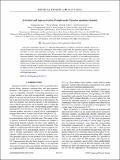| dc.contributor.author | Lim, Youngrong | |
| dc.contributor.author | Takagi, Ryuji | |
| dc.contributor.author | Adesso, Gerardo | |
| dc.contributor.author | Lee, Soojoon | |
| dc.date.accessioned | 2019-06-17T17:26:52Z | |
| dc.date.available | 2019-06-17T17:26:52Z | |
| dc.date.issued | 2019-03 | |
| dc.date.submitted | 2019-01 | |
| dc.identifier.issn | 2469-9926 | |
| dc.identifier.issn | 2469-9934 | |
| dc.identifier.uri | https://hdl.handle.net/1721.1/121324 | |
| dc.description.abstract | Activation of quantum capacity is a surprising phenomenon according to which the quantum capacity of a certain channel may increase by combining it with another channel with zero quantum capacity. Superactivation describes an even more particular occurrence, in which both channels have zero quantum capacity, but their composition has a nonvanishing one. We investigate these effects for all single-mode phase-insensitive Gaussian channels, which include thermal attenuators and amplifiers, assisted by a two-mode positive-partial-transpose channel. Our result shows that activation phenomena are special but not uncommon. We can reveal superactivation in a broad range of thermal attenuator channels, even when the transmissivity is quite low, or the thermal noise is high. This means that we can transmit quantum information reliably through very noisy Gaussian channels with the help of another Gaussian channel, whose quantum capacity is also zero. We further show that no superactivation is possible for entanglement-breaking Gaussian channels in physically relevant circumstances by proving the nonactivation property of the coherent information of bosonic entanglement-breaking channels with finite input energy. | en_US |
| dc.publisher | American Physical Society | en_US |
| dc.relation.isversionof | http://dx.doi.org/10.1103/PhysRevA.99.032337 | en_US |
| dc.rights | Article is made available in accordance with the publisher's policy and may be subject to US copyright law. Please refer to the publisher's site for terms of use. | en_US |
| dc.source | American Physical Society | en_US |
| dc.title | Activation and superactivation of single-mode Gaussian quantum channels | en_US |
| dc.type | Article | en_US |
| dc.identifier.citation | Lim, Youngrong et al. "Activation and superactivation of single-mode Gaussian quantum channels." Physical Review A 99, 3 (March 2019): 032337 © 2019 American Physical Society | en_US |
| dc.contributor.department | Massachusetts Institute of Technology. Center for Theoretical Physics | en_US |
| dc.contributor.department | Massachusetts Institute of Technology. Department of Physics | en_US |
| dc.relation.journal | Physical Review A | en_US |
| dc.eprint.version | Final published version | en_US |
| dc.type.uri | http://purl.org/eprint/type/JournalArticle | en_US |
| eprint.status | http://purl.org/eprint/status/PeerReviewed | en_US |
| dc.date.updated | 2019-03-25T18:00:10Z | |
| dc.language.rfc3066 | en | |
| dc.rights.holder | American Physical Society | |
| dspace.orderedauthors | Lim, Youngrong; Takagi, Ryuji; Adesso, Gerardo; Lee, Soojoon | en_US |
| dspace.embargo.terms | N | en_US |
| dspace.date.submission | 2019-04-04T11:13:33Z | |
| mit.journal.volume | 99 | en_US |
| mit.journal.issue | 3 | en_US |
| mit.license | PUBLISHER_POLICY | en_US |
